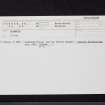Eyemouth, Rottendub
Bank (Earthwork) (Medieval), Burial (Medieval), Ditch(S) (Medieval), Midden (Medieval), Tenement (19th Century)
Site Name Eyemouth, Rottendub
Classification Bank (Earthwork) (Medieval), Burial (Medieval), Ditch(S) (Medieval), Midden (Medieval), Tenement (19th Century)
Alternative Name(s) Old Kirk
Canmore ID 60274
Site Number NT96SW 80
NGR NT 94555 64303
Datum OSGB36 - NGR
Permalink http://canmore.org.uk/site/60274
- Council Scottish Borders, The
- Parish Eyemouth
- Former Region Borders
- Former District Berwickshire
- Former County Berwickshire
NT96SW 80 9456 6428
See also NT96SW 91.
On the S side of Chapel Street, two sites were available for excavation; a small plot at the end of Mason's Wynd on the street frontage and another in the yard behind, at the back of the Auld Kirk, now a Museum, on the site of what was previously occupied by a late 18th century brick-built tenement. The latter or Kirk site was selected for excavation because there was no reason to expect better results on the S side of Chapel Street than obtained on the N side. In contrast to the British Legion Sheltered Housing site (NT96SW 91), this site produced medieval deposits up to one metre deep which comprised a medieval rubbish dump covering the period from c.1200-1500 AD.
Further to this, the demolition of the buildings on Chapel Street in the spring of 1984, prior to the development of the yard behind the Museum as a car park, provided the opportunity to try and define the limits of these medieval deposits.
Consequently in April 1984 two trenches were opened up to examine the area to the E and N of the 1982 excavations. This was intended not only to assess the extent of the medieval rubbish dump found in the 1982 excavations, but also whether or not there were any medieval structures in this area. Apart from the isolated burial of a teenage girl found in late medieval levels, a similar deposit to that encountered in 1982 was apparent. Furthermore there was no indication that the limits of the rubbish dump had been reached either to the N or E, and a contractors trench across Manse Road indicated that the deposits continued to the W. However, the demolition revealed that the houses on the S side of Chapel Street were terraced into the ground up to about 2m. This supprts the conclusion that the medieval deposits were removed from the British legion site prior to its development in the late 18th century.
P Dixon 1986.
Field Visit (1982 - 1988)
The Manpower Services Commission funded Border Burghs Archaeology project (sponsored by Borders Architects Group) carried out excavations in the burghs of the region, created the Sites and Monuments Record for Borders Region and carried out field survey in support, including plane table surveys of selected sites under the direction of Dr Piers Dixon.
Sbc Note
Visibility: This site has been excavated.
Information from Scottish Borders Council








